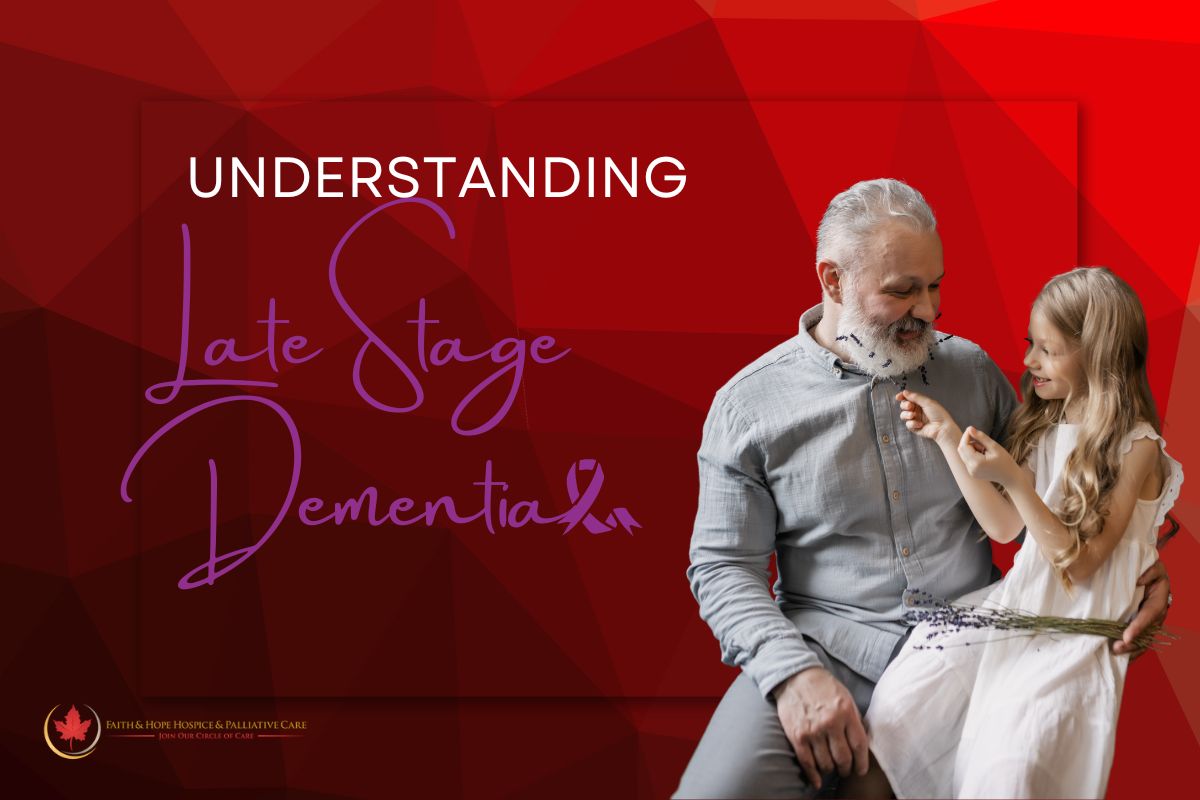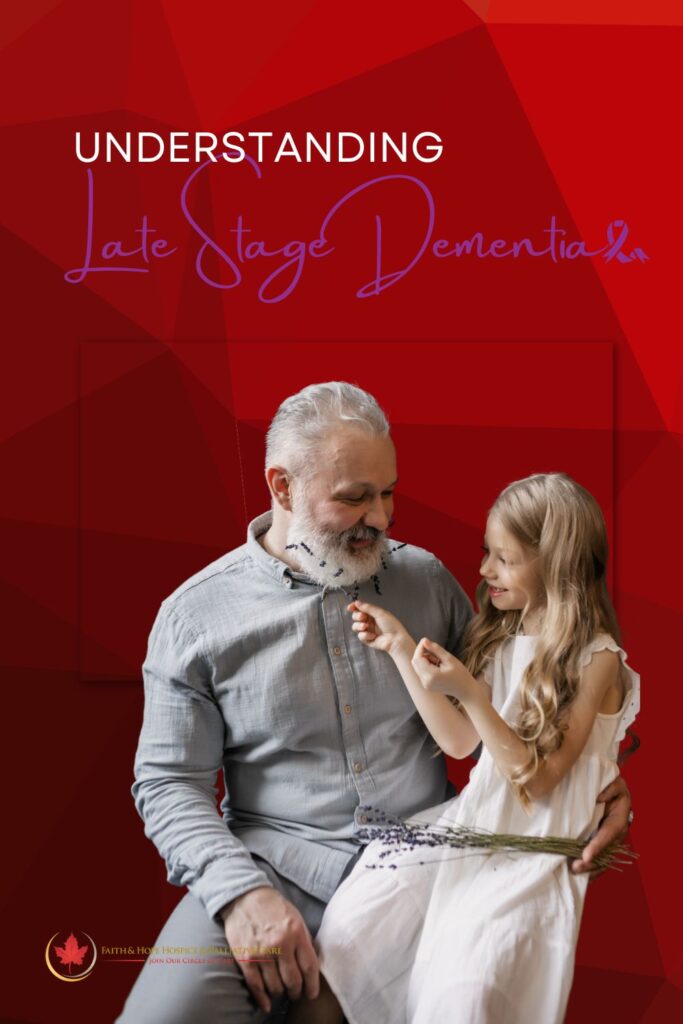
Late-stage dementia, also known as severe dementia, refers to a patient affected by the disease for a prolonged time. A person at this stage is now experiencing permanent damage to their brain. Because of this, constant care is required for the individual. Los Angeles hospice or palliative care is necessary at this stage.

A Los Angeles hospice patient with late-stage dementia may not be able to recognize people who are near them or distinguish between everyday objects. They might thus feel exposed and unsure of what is going on. Providing assurance and sustaining calm is crucial. Moments of recognition and connection may occur, which presents an opening for interaction.
Even if you’re not sure they understand, it’s still crucial to keep talking to the person, share your news with them, and discuss topics that interest you. Even after they lose the ability to speak, people with dementia frequently communicate through their facial expressions, body language, and emotions. Try using smaller sentences; a one or two-word response may be easier for them to understand.
People with late-stage dementia may believe they are living in an earlier period in their younger decades. Talking about their past and the people and places they know and love can helpful at this time.
It can be helpful to encourage someone to eat the nutritious food they need. Small, frequent snacks may be preferable to set meals. However, over time, the muscles and reflexes may stop functioning as they should, making chewing and swallowing more challenging. Chest infections or choking can result from this. Drinks may need to be thickened, and food textures may need to adjust. It can be helpful to consult with a nutritionist or speech therapist for guidance.
A patient may lose their ability to control one’s bowel and bladder. Getting support from your doctor or a nurse is crucial if you want guidance on continence aids and how to prevent and treat an infection.
Eventually, a patient can appear to be asleep more often than awake, and this frequently occurs in late-stage dementia and can be challenging for the family to deal with. If you have any worries about spending a lot of time sleeping, speak to your doctor or nurse.
The individual may then be able to relate emotionally and favorably to past interests. Doing this will reinforce positive memories for them, providing them with a sense of familiarity and comfort.
Despite the language being a concrete aspect of our daily lives, most communication is non-verbal. Although Los Angeles hospice care patients struggle with speaking, some can still pick up on non-verbal cues.
This makes it possible for the person to connect with others, which may be incredibly satisfying and lessen their feelings of loneliness. However, if remaining silent feels too uncomfortable, playing music, reading aloud from a favorite book, or just holding an object with sentimental value might help to focus the time you spend with the other person.
If a doctor has identified late-stage dementia in your relative, Los Angeles palliative care or hospice care staff will help ensure a comfortable and high quality of end-of-life care for your loved one. Please call our toll-free number (877) 797-1977 today.
Faith and Hope Hospice
We firmly believe that the internet should be available and accessible to anyone, and are committed to providing a website that is accessible to the widest possible audience, regardless of circumstance and ability.
To fulfill this, we aim to adhere as strictly as possible to the World Wide Web Consortium’s (W3C) Web Content Accessibility Guidelines 2.1 (WCAG 2.1) at the AA level. These guidelines explain how to make web content accessible to people with a wide array of disabilities. Complying with those guidelines helps us ensure that the website is accessible to all people: blind people, people with motor impairments, visual impairment, cognitive disabilities, and more.
This website utilizes various technologies that are meant to make it as accessible as possible at all times. We utilize an accessibility interface that allows persons with specific disabilities to adjust the website’s UI (user interface) and design it to their personal needs.
Additionally, the website utilizes an AI-based application that runs in the background and optimizes its accessibility level constantly. This application remediates the website’s HTML, adapts Its functionality and behavior for screen-readers used by the blind users, and for keyboard functions used by individuals with motor impairments.
If you’ve found a malfunction or have ideas for improvement, we’ll be happy to hear from you. You can reach out to the website’s operators by using the following email
Our website implements the ARIA attributes (Accessible Rich Internet Applications) technique, alongside various different behavioral changes, to ensure blind users visiting with screen-readers are able to read, comprehend, and enjoy the website’s functions. As soon as a user with a screen-reader enters your site, they immediately receive a prompt to enter the Screen-Reader Profile so they can browse and operate your site effectively. Here’s how our website covers some of the most important screen-reader requirements, alongside console screenshots of code examples:
Screen-reader optimization: we run a background process that learns the website’s components from top to bottom, to ensure ongoing compliance even when updating the website. In this process, we provide screen-readers with meaningful data using the ARIA set of attributes. For example, we provide accurate form labels; descriptions for actionable icons (social media icons, search icons, cart icons, etc.); validation guidance for form inputs; element roles such as buttons, menus, modal dialogues (popups), and others. Additionally, the background process scans all the website’s images and provides an accurate and meaningful image-object-recognition-based description as an ALT (alternate text) tag for images that are not described. It will also extract texts that are embedded within the image, using an OCR (optical character recognition) technology. To turn on screen-reader adjustments at any time, users need only to press the Alt+1 keyboard combination. Screen-reader users also get automatic announcements to turn the Screen-reader mode on as soon as they enter the website.
These adjustments are compatible with all popular screen readers, including JAWS and NVDA.
Keyboard navigation optimization: The background process also adjusts the website’s HTML, and adds various behaviors using JavaScript code to make the website operable by the keyboard. This includes the ability to navigate the website using the Tab and Shift+Tab keys, operate dropdowns with the arrow keys, close them with Esc, trigger buttons and links using the Enter key, navigate between radio and checkbox elements using the arrow keys, and fill them in with the Spacebar or Enter key.Additionally, keyboard users will find quick-navigation and content-skip menus, available at any time by clicking Alt+1, or as the first elements of the site while navigating with the keyboard. The background process also handles triggered popups by moving the keyboard focus towards them as soon as they appear, and not allow the focus drift outside it.
Users can also use shortcuts such as “M” (menus), “H” (headings), “F” (forms), “B” (buttons), and “G” (graphics) to jump to specific elements.
We aim to support the widest array of browsers and assistive technologies as possible, so our users can choose the best fitting tools for them, with as few limitations as possible. Therefore, we have worked very hard to be able to support all major systems that comprise over 95% of the user market share including Google Chrome, Mozilla Firefox, Apple Safari, Opera and Microsoft Edge, JAWS and NVDA (screen readers).
Despite our very best efforts to allow anybody to adjust the website to their needs. There may still be pages or sections that are not fully accessible, are in the process of becoming accessible, or are lacking an adequate technological solution to make them accessible. Still, we are continually improving our accessibility, adding, updating and improving its options and features, and developing and adopting new technologies. All this is meant to reach the optimal level of accessibility, following technological advancements. For any assistance, please reach out to
